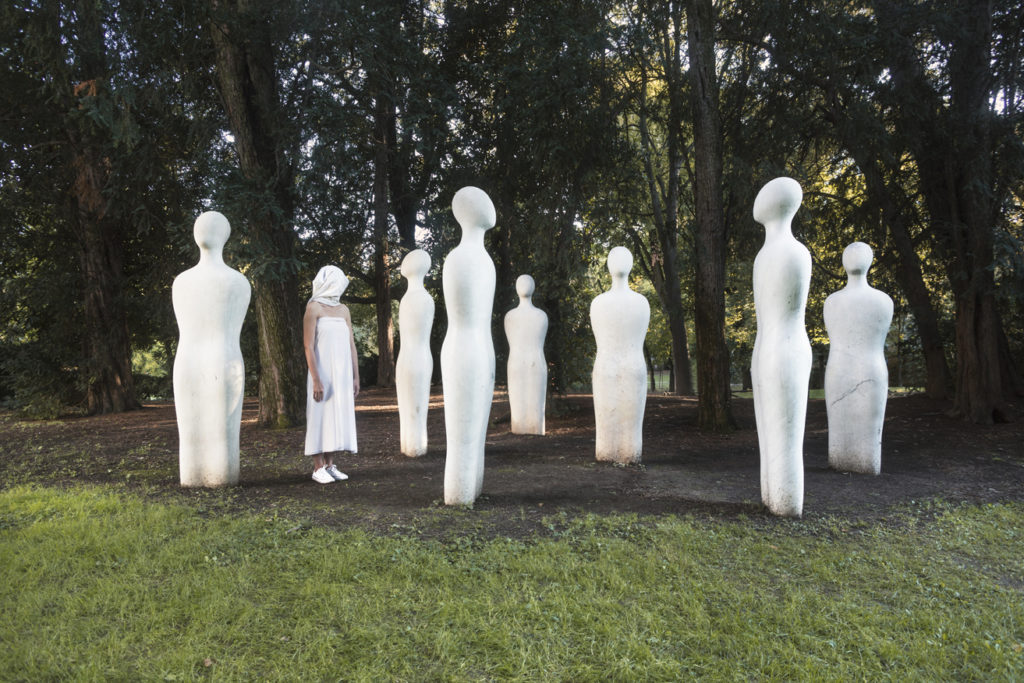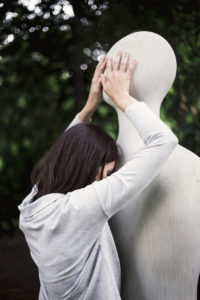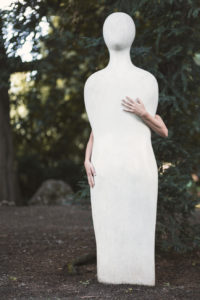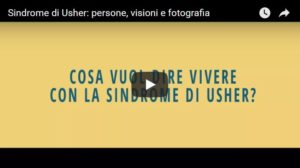Durante l’estate del 2017 Stefano Scagliarini ha contattato NoisyVision per chiedere un contributo per la sua tesi. Noi gli abbiamo risposto immediatamente, certi che l’apporto che poteva dare alla conoscenza della Sindrome di Usher poteva giovare di un punto di vista esterno e del talento artistico.
La tesi é stata premiata con lode e il progetto avrá un seguito.
La storia qui riportata è ambientata a Milano, quella di Dario a Berlino, quella di Alessandro a Genova.
Tre storie, tre persone, tre cittá per un denominatore comune: la Sindrome di Usher. Raccontarla e fotografarla puó diventare arte e poesia, come ci racconta Luigina.
“Ciao Luigina!”
Una voce fuori campo visivo mi saluta, deve essere Stefano Scagliarini, il laureando in Design della Comunicazione del Politecnico di Milano che sto aspettando all’uscita della fermata della metro di Moscova.
Stefano ha contattato NoisyVision per coinvolgere alcuni soci nel suo progetto di tesi.
Mi guardo velocemente intorno, di fronte, a destra e a sinistra e ancora di nuovo di fronte, a destra e a sinistra, eppure non lo vedo.
Dopo qualche secondo di affanno, finalmente il mio sguardo intercetta il volto di un ragazzo che mi sta guardando sorridendo. Stupito e incuriosito, ma gentile.
È la prima volta che ci incontriamo: una sorta di appuntamento al buio in un assolato pomeriggio di luglio.
Gli avevo detto che avrei indossato un vestito a righe bianche e blu, ma non gli avevo fornito particolari istruzioni per l’uso, come per esempio quella di posizionarsi di fronte a me quando sarebbe arrivato, e non di lato.
Ma, a ben pensarci, quale modo migliore per immergersi nel mio mondo per chi sta realizzando una tesi dal titolo Blind Images. Metodi accessibili di autorappresentazione fotografica ?
(Abstract della tesi qui)
Ci sediamo all’ombra sotto il gazebo di un bar e Stefano mi illustra il suo progetto di tesi, che può essere riassunto con tre parole chiave: fotografia, cecità e sinestesia.
Appassionato da sempre di fotografia e diplomato presso il CFP Bauer, ha effettuato una approfondita ricerca teorica sui temi della vista e dell’oculocentrismo, della cecità e dell’ipovisione e della progettazione sinestesica. Vuole, attraverso la sua tesi, contribuire a modificare la gerarchia sensoriale dominante nella nostra società e proporre un approccio, tanto nella percezione quanto nella comunicazione, che vada oltre alla vista e coinvolga più sensi contemporaneamente. Intende realizzare questo obiettivo attraverso la fotografia, il mezzo che più di tutti è per antonomasia legato al senso della vista, e il contributo e l’esperienza di persone cieche e/o ipovedenti. Persone, cioè, abituate a “vedere” ed esprimersi con altri sensi, prima che con la vista. Ispirandosi al primo esempio di fotografia realizzata come denuncia ed espressione di uno stato d’animo interiore, l’Autoritratto in posa da annegato di Hippolyte Bayard (1840), Stefano vorrebbe corredare la sua tesi di una serie di autoritratti studiati e progettati come una messa in scena e che esprimano ciascuno una caratteristica precisa delle persone con disabilità visiva che, con la sua guida e il suo supporto, realizzeranno la rappresentazione fotografica di sé.

Quindi l’autoritratto come mezzo di conoscenza di se stessi e come autoterapia. La fotografia come espressione di uno specifico messaggio, ma anche come strumento e ponte per creare relazioni umane, condivisione di saperi e coinvolgimento reciproco – di soggetto e designer – nel raggiungimento di un obiettivo progettuale comune. I sensi come parte integrante e significativa dell’intero processo, nelle tre fasi di ideazione, realizzazione e fruizione. La progettazione scaturirà infatti dai sensi delle persone ritratte e si estrinsecherà attraverso il percorso percettivo personale di ciascun soggetto; la fruizione delle fotografie sarà poi accessibile a tutti, normovedenti e non, attraverso l’associazione e la traduzione di stimoli sensoriali.
Dalla teoria scivoliamo alla pratica: Stefano mi chiede cosa mi piacerebbe esprimere della mia condizione visiva e mi invita a partire da una canzone. Il collegamento è immediato. Comincio a parlare di Wasting my young years dei London Grammar. La canzone parla di una storia d’ amore conclusa e per me descrive l’incapacità di superare un ostacolo, di avvicinarsi davvero a qualcuno o di realizzare un proprio sogno per paura. Non agire a causa di questo sentimento equivale a rinunciare a vivere, in senso lato, e significa rimanere immobili, perdendosi gli anni e i momenti migliori. Senza quasi accorgermene, mi ritrovo a parlare del momento della mia diagnosi avuta quando avevo 25 anni. Lo ricordo come fosse ieri: la specializzanda, che mi aveva appena effettuato l’OCT, esce dalla stanza e si rivolge a mia madre, senza neanche guardarmi. Sento dirle che il risultato del test evidenzia un sospetto di retinite pigmentosa, da verificare con visita oftalmologica.
… So cosa voglio raccontare attraverso il mio autoritratto!
Voglio esprimere la paura immobilizzante che ho provato dopo aver scoperto di avere una patologia degenerativa non curabile, che mi avrebbe gradualmente portato a perdere la vista.
Stefano ed io ci salutiamo dopo due ore di chiacchierata, entrambi convinti ed entusiasti di lavorare insieme.
Segue uno scambio di email nelle quali ci confrontiamo su come sviluppare da un punto di vista iconografico e iconologico il tema da me individuato e sui luoghi di Milano che avremmo percorso per realizzare la video intervista e il reportage, che nella tesi avrebbero introdotto il mio autoritratto.
Ci incontriamo a settembre.
Dò appuntamento a Stefano e alla fidanzata Clorinda a Piazza Sant’Alessandro, un angolo di Milano che amo molto, e, camminando, mi racconto.
Stefano si fa interprete discreto e fedele della mia persona. Mi accompagna fotografandomi in un itinerario di luoghi nascosti e ricchi di storia, che rispecchiano la mia passione per l’arte.
Di solito non amo né essere ripresa né essere fotografata, eppure non c’è un istante nel quale mi senta in imbarazzo. Prezioso è il contributo di Clorinda, che in punta di piedi fa fronte a qualsiasi necessità. La maggior parte delle foto del reportage e l’autoritratto vengono scattati nel parco di Villa Belgiojoso in via Palestro, a Milano. Compio un vero e proprio viaggio, di attivazione della percezione sensoriale, di scoperta e di interazione con i diversi elementi presenti, come alberi, foglie, radici e statue; un viaggio che rende possibile il mio racconto senza parole dell’ipovisione. L’autoritratto ne è la perfetta conclusione. Fa da scenario il gruppo scultoreo I sette savi di Fausto Melotti (1981), che si trova dietro il Padiglione di Arte Contemporanea (PAC), prospiciente Villa Belgiojoso.
L’opera originaria, realizzata nel 1936, comprendeva dodici statue in marmo bianco di Carrara, che però andarono parzialmente distrutte. L’autore, dovendo ricostruire l’opera, decise di realizzarne sette simili, ma ciascuna differente dalle altre. Nonostante la loro conformazione quasi geometrica, viste insieme le sculture sembrano persone vere, ognuna immersa nei suoi pensieri, con lo sguardo rivolto verso l’alto e che non incontra mai la traiettoria di quello delle compagne. L’aspetto quasi sacrale, totemico delle sette statue crea un ritmo rigoroso che ben dialoga con l’ambiente e l’atmosfera circostante. Confrontandomi con Stefano, decido di coprirmi il volto con un panno e di avvolgere il mio corpo con un lenzuolo, entrambi bianchi. Come se fossi l’ottavo elemento del gruppo, mi colloco, stante, tra le statue.
Non potevo trovare un modo migliore per rappresentare la staticità fisica del momento che ha dato inizio alla mia storia di ipovedente, la rivelazione della retinite pigmentosa e la scoperta di un futuro incerto e imprevedibile. Il corpo nel pieno della mia giovinezza si fa pesante e freddo come il marmo delle statue che mi circondano, ma non mi osservano. Il panno bianco sul mio volto, di eco magrittiana, crea sul suo viso delle pieghe, dei percorsi di luce e ombra senza lasciare trapelare la mia identità. Questo per sottolineare l’idea di immobilismo emotivo e l’annullamento totale delle mie speranze e dei miei sogni.
Annullamento che, per fortuna, si è rivelato temporaneo. Grazie al sostegno dei miei familiari e dei miei amici e delle persone eccezionali che, proprio grazie alla retinite pigmentosa, ho incontrato sul mio cammino. In questa sede non posso non citare Dario e Alessandro, miei compagni di avventura Usher, che hanno partecipato come me al progetto di tesi di Stefano, ciascuno raccontando la sua storia.
Spesso i limiti che ci impongono le nostre paure e i nostri pregiudizi sono ben più invalidanti di quelli fisici. Certo, convivere con un limite uditivo e visivo è spesso complicato, ma non è una ragione sufficiente per rinunciare a vivere con entusiasmo e a seguire le proprie passioni.
Grazie, Stefano, per esserci venuto a cercare e per averci dato l’opportunità di dimostrare che si può andare oltre la visione.
L’ autoritratto descritto nel testo
Le altre foto del reportage
Nota: tutte le foto sono di proprietá di Stefano Scagliarini. Vietata riproduzione senza autorizzazione.







WOW great photos. I don’t know if you have heard about him but there is a very famous photographer who has recently revealed that he is blind and he is still, while not seeing taking photos all the same. His name is David Katz and if you visit his website (http://throughmylenses.org/) you will see many great photos taken from many very powerful and significant moments.
Katz recently revealed that there is a tool that really helps him in his day to day life, and also in his work as a photographer. It is a gadget called Orcam Myeye, it is basically a kind of <a href="https://www.orcam.com/" blind glasses
that can read texts and identify faces for you. You should check it out, because according to Katz Orcam really helped him.